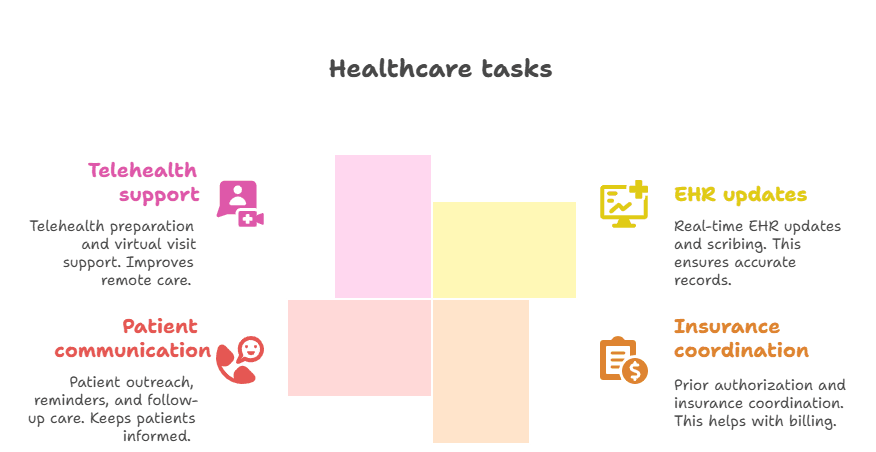On-Demand Outsourcing BPO Services for Healthcare Providers With 24/7 Coverage!
Save up to 70% on staffing costs!
Browse Specialty Staffing ServicesHow VMA Transformed My Practice: Real Stories from Digital Health Innovators?

Dr. Lopez enters her office for a day packed with appointments. Instead of drowning in paperwork and EHR clicks, she’s greeted by a streamlined dashboard powered by her Virtual Medical Assistant (VMA).
Her first patient, Angela, a busy working mom, discusses her lab results and new symptoms. Dr. Lopez is fully present—no typing, no toggling between screens. Behind the scenes, her VMA updates the EHR, prepares prescription orders, and even queues up patient education materials.
By the time Angela leaves, her follow-up appointment is scheduled, lab reminders are set, and a care summary is already in her inbox.
This isn’t the future—it’s today.
The Great Shift: From Burdened to Balanced
Virtual Medical Assistants (VMAs) are redefining how care is delivered. Once considered experimental, VMAs are now essential tools allowing physicians to focus on medicine—not administrative grind.
As clinician burnout reaches historic levels and patient expectations for seamless digital care increase, VMAs are bridging the gap between compassionate care and operational efficiency.
What Are Virtual Medical Assistants (VMAs)?
VMAs are remote professionals—human or AI-supported—trained in healthcare workflows who take on clinical and administrative tasks. They integrate with EHRs, streamline office operations, and enhance provider-patient interactions.
Benefits Include:
• 70% reduction in administrative workload
• Improved patient satisfaction and communication
• Fewer errors in scheduling and documentation
• More provider face time with patients
How VMAs Are Changing Clinical Practice
VMAs aren’t just about documentation—they act as extensions of the care team, supporting:

• Real-time EHR updates and scribing
• Prior authorization and insurance coordination
• Patient outreach, reminders, and follow-up care
• Telehealth preparation and virtual visit support
This allows providers to dedicate their energy to what matters most—delivering personalized care.
Why 2025 Is the VMA Breakthrough Year
Key forces driving this transformation include:
-
Burnout Epidemic: Over 60% of clinicians report burnout. VMAs reduce paperwork, freeing physicians to focus on patients.
-
Digital-First Patients: On-demand communication and frictionless scheduling are now standard expectations.
-
Staffing Shortages: With fewer in-office staff available, VMAs fill critical gaps remotely and cost-effectively.
-
Integrated Technology: EHR vendors and regulatory bodies now support remote VMA access and HIPAA-compliant workflows.
-
Proven ROI: Clinics adopting VMAs report a 50–65% decrease in admin costs while increasing patient capacity.
Real Stories: Frontline Success with VMAs
At a pediatric clinic in Denver, adopting VMAs resulted in:
• A 45% increase in daily patient throughput
• An 80% drop in after-hours administrative work
• A 25% improvement in patient response times for follow-up care
Dr. Kim, the lead pediatrician, shared: “I finally feel like I’m practicing medicine again instead of being buried in paperwork.”
Staffingly: Enabling Practices to Thrive
Staffingly equips healthcare organizations with highly skilled, HIPAA-compliant VMAs who transform how clinics run:
• Virtual Medical Assistants: EHR-trained professionals supporting documentation and admin tasks.
• Clinical Support Teams: Assistance with care coordination and patient outreach.
• Telehealth Enablement: Seamless remote visit workflows and tech support.
• Revenue Cycle Support: Insurance verification, billing assistance, and claims tracking.
What Did We Learn?
-
VMAs Are Transformative, Not Just Supportive: Virtual Medical Assistants (VMAs) are no longer optional add-ons—they are reshaping clinical workflows and enabling physicians to reclaim time for patient care.
-
Burnout Solutions Are Here: With administrative tasks consuming hours daily, VMAs significantly reduce documentation, scheduling, and follow-up burdens, directly addressing physician burnout.
-
Patient Experience is Elevated: By streamlining operations and enhancing communication, VMAs help create a patient-centered care model where individuals feel heard, informed, and supported.
-
Efficiency = Growth: Clinics leveraging VMAs report improved patient throughput, reduced after-hours work, and operational cost savings up to 65%—proof that VMAs drive both clinical and business success.
-
2025 Is the Tipping Point: Regulatory support, integrated EHR systems, and workforce shortages have made VMAs an essential component of modern healthcare, ensuring practices remain competitive.
-
Staffingly Leads the Way: By providing HIPAA-compliant, trained VMAs, Staffingly empowers practices to seamlessly implement these solutions and achieve sustainable, scalable care delivery.
What people are asking?
1. What is a Virtual Medical Assistant (VMA)?
A Virtual Medical Assistant is a remote, HIPAA-compliant professional (human or AI-augmented) trained in medical workflows. They handle administrative and clinical support tasks such as documentation, scheduling, patient communication, and EHR management.
2. How do VMAs differ from AI scribes?
AI scribes focus solely on listening to patient-provider conversations and creating clinical notes, while VMAs provide broader support, including EHR updates, patient follow-ups, insurance coordination, and telehealth preparation.
3. Are VMAs HIPAA-compliant?
Yes. All Staffingly VMAs undergo rigorous training in HIPAA compliance and U.S. healthcare standards to ensure patient data privacy and security.
4. What tasks can VMAs handle?
VMAs can:
• Document patient encounters and update EHRs
• Schedule and manage appointments
• Handle prescription refills and authorizations
• Coordinate lab orders and follow-ups
• Support telehealth visits
• Manage insurance verification and billing tasks
5. How do VMAs integrate with existing systems?
VMAs are trained to work directly within popular EHR platforms and clinic workflows. They access systems securely, just like an in-house team member, but operate remotely to reduce overhead.
6. What impact do VMAs have on physician burnout?
VMAs reduce administrative burden by up to 70%, freeing providers from after-hours charting and paperwork so they can focus on patient care and regain work-life balance.
7. Are VMAs cost-effective for small practices?
Yes. VMAs can reduce operational costs by 50–65% compared to in-house staffing while delivering the same (or better) level of efficiency.
8. Do VMAs work only for telehealth practices?
No. VMAs support both in-person and virtual care settings, making them ideal for hybrid practices or clinics looking to expand their digital offerings.
Disclaimer
For informational purposes only; not applicable to specific situations.
For tailored support and professional services,
Please contact Staffingly, Inc. at (800) 489-5877
Email : support@staffingly.com.
About This Blog : This Blog is brought to you by Staffingly, Inc., a trusted name in healthcare outsourcing. The team of skilled healthcare specialists and content creators is dedicated to improving the quality and efficiency of healthcare services. The team passionate about sharing knowledge through insightful articles, blogs, and other educational resources.
 Book a Demo to Build Your Team Today!
Book a Demo to Build Your Team Today!

 Read Case Studies
Read Case Studies 



 Virtual Medical Assistants
Virtual Medical Assistants



